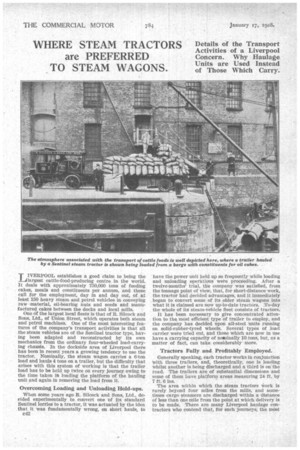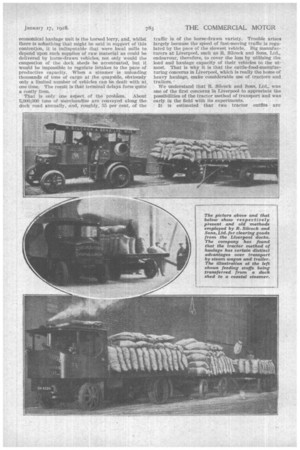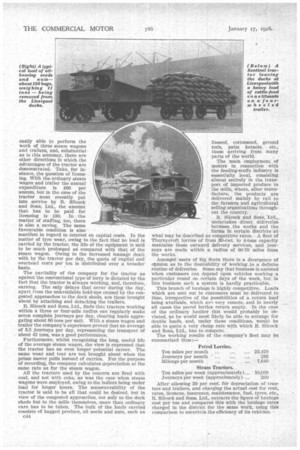WHERE STEAM TRACTORS
Page 64

Page 65

Page 66

If you've noticed an error in this article please click here to report it so we can fix it.
are PREFERRED
TO STEAM WAGONS.
Details of the Transport Activities of a Liverpool Concern. Why Haulage Units are Used Instead of Those Which Carry.
TIVERPOOL establishes a good claim to being the I largest cattle-food-producing centre in the world. It deals with approximately 750,000 tons of feeding cakes, meals and constituents per annum, and these call for the employment, day in and day out, of at least 150 heavy steam and petrol vehicles in conveying raw ,material, oil-bearing nuts and seeds and manufactured cakes between the docks and local mills.
One of the largest local fleets is that of It. Silcock and Sons, Ltd., of Union Street, which operates both steam and petrol machines. One of the most interesting features of the company's transport activities is that all the steam vehicles are of the Sentinel tractor type, having been adapted and reconstructed by its own mechanics from the ordinary four-wheeled load-carrying chassis. In the dockside area of Liverpool there has been in recent years a growing tendency to use the tractor. Nominally, the steam wagon carries a 6-ton load and hauls 4 tons on a trailer, but the difficulty that arises with this system of working is that the trailer load has to be held up twice on every journey owing to the time taken in loading the platform of the hauling unit and again in removing the load from it.
Overcoming Loading and Unloading Hold-ups.
When some years ago R. Snood< and Sons, Ltd., decided experimentally to convert one of its standard Sentinel lorries to a tractor, it was actuated by the idea that it was fundamentally wrong, on short hauls, to c42 have the power unit held up so frequently while loading and unloading operations were proceeding. After a twelve-months' trial, the company was satisfied, from the tonnage point of view, that, for short-distance work, the tractor had decided advantages, and it immediately began to convert some of its older steam wagons into what it is claimed are now up-to-date tractors. To-day the whole of its steam-vehicle fleet consists of tractors.
It has been necessary to give concentrated attention to the most efficient type of trailer to employ, and the company has decided upon all-steel units running on solid-rubber-tyred wheels. Several types of load carrier were tried out, and those which are now in use have a carrying capacity of nominally 10 tons, but, as a matter of fact, can take considerably more.
Tractors Fully and Profitably Employed.
Generally speaking, each tractor works in conjunction with three trailers, and, theoretically, one is loading whilst another is being discharged and a third is on the road. The trailers are of substantial dimensions and some of them have platform areas measuring 24 ft. by 7 ft. 6 ins.
The area within which the steam tractors Work is rarely beyond four miles from the mills, and sometimes cargo steamers are discharged within a distance of less than one mile from the point at which delivery is to be made. There are many Liverpool haulage contractors who contend that, for such journeys, the mOst econotaical haulage unit is the horsed lorry, and, whilst there is sofnething that might be said in supticirt of this contention, it is indisputable that were local mills to depend upon such supplies'of raw material as could be delivered by horse-drawn vehicles, not only would the congestion of the dock sheds be accentuated, but it would be impossible to regulate intakes to the pace of productive capacity. When a steamer is unloading thousands of tons of cargo at the quayside, obviously only a limited number of vehicles can he dealt with at one time. The result is that terminal delays form quite a Costly item. That is only one aspect of the problem About 5,000,000 tons ofmerchandise are conveyed along the dock road annually, and, roughly, 55 per cent, of the
traffic is of the horse-drawn variety. Trouble arises largely because the speed of fast-moving traffic is regulated .by the pace of the slowest vehicle. Big manufacturers at Liverpool, such as R. Silcock and Sons, Ltd., endeavour, therefore, to cover the loss by utilizing the load and haulage capacity of their vehicles to the ut• most. That is why it is that the cattle-food-manufacturing concerns in Liverpool, which is really the home of heavy haulage, make considerable use of tractors and trailers.
We understand that R. Silcock and Sons, Ltd., was one of the first concerns in Liverpool to appreciate the possibilities of the tractor method of transport and was early in the field with its experiments.
It is estimated that two tractor outfits. are .
easily able to perform the work of three steam wagons and trailers, and, substantial as is this economy, there are other directions in which the advantages of the tractor are demonstrated. Take, for instance, the question of licens ing. With the ordinary steam wagon and trailer the annual expenditure is £66 per annum, but in the case of the tractor most recently put into service by It. Silcock and Sons, Ltd., the amount
that has to be paid for licensing is £30. In the
matter of staffing, too, there Is also a saving. The same favourable condition is also
manifest in regard to interest on capital costs. In the matter of tyre wear, owing to the fact that no load is carried by the tractor, the life of the equipment is said to be much prolonged as compared with that of the steam wagon. Owing to the increased tonnage dealt. with by the tractor per day, the quota of capital and overhead costs per ton is distributed over a broader basis.
The partiality of the company for the tractor as against the conventional type of lorry is dictated by the fact that the tractor is -always working, and, therefore, earning. The only delays that occur during the day, apart from the unavoidable hold-ups caused by the congested approaches to the dock sheds, are those brought about by attaching and detaching the trailers.
R. Silcock and Sons, Ltd., finds that tractors working within a three or four-mile radius can regularly make seven complete journeys per day, clearing loads aggregating about 80 tons per unit. With a steam wagon and trailer the company's experience proved that an average of 3.5 journeys per day, representing the transport of about 42 tons, was a good performance.
Furthermore, whilst recognizing the long, useful life of the average steam wagon, the view is expressed that the tractor has an even longer potential career. The same wear and tear are not brought about when the prime mover pulls instead of carries. For the purpose of recording, the company calculates depreciation at the same rate as for the steam wagon.
All the tractors used by the concern are fired with coal, and not with coke, as was the case when steam wagons were employed, owing to the boilers being under load for longer hours. The manceuvrability of the tractor is said to be all that could be desired, but in view of the congested approaches, not only to the dock sheds but to the mills themselves, more than ordinary care has to be taken. The bulk of the loads carried consists of bagged produce, oil seeds and nuts, such as 044 linseed, cottonseed, ground nuts, palm kernels, etc., these arriving from many parts of the world.
The main employment of motors in connection with the feeding-stuffs industry is essentially local, consisting almost entirely in the transport of imported produce to the mills, where, after manufacture, the products are delivered mainly by rail to the farmers and agricultural selling organizations throughout the country.
Silcock and Sons, Ltd., . undertakes direct deliver:es between the works and the farms in certain districts at what may be described as competitive rates. A fleet of Thornycroft lorries of from 30-cwt. to 4-tons capacity mantains these outward delivery services, and journeys are made within a radius of 60-70 miles from the works.
Amongst users of big fleets there is a divergence of opinion as to the desirability of working ,to a definite routine of deliveries. Some say that business is assisted when customers can depend upon vehicles working a particular round on certain days of the week, but in this business such a system is hardly practicable. •
This branch of haulage is highly competitive. Loads which are sent out to customers must be delivered to time, irrespective of the possibilities of a return load being available, which are very remote, and in nearly all cases the petrol lorries return empty. In the case of the ordinary haulier this would probably be obviated, as he would most likely be able to arrange for double loads, and, under these conditions, would be able to quote a very cheap rate with which R. Silcock and Sons, ma., has to compete.
The working results of the company's fleet may lae summarized thus :- Petrol Lorries.
Ton miles per month ... ... 25,470 Journeys per month 233 Mileage per month 7,640 Steam Tractors.
Ton miles per week (approximately)... 10,000 Journeys per week (approximately)-... 260 After allowing 20 per cent. for depreciation of tractors and trailers, and charging the actual cost for rent, rates, licences, insurance, maintenance, fuel, tyres, etc., R. Silcock and Sons, Ltd., extracts the figure of haulage cost per ton and compares this with the haulage rates charged in the district for the same work, using this comparison to ascertain the efficiency of its vehicles.












































































































